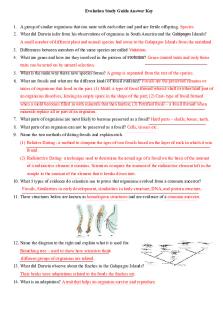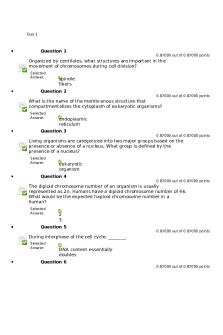Quiz 2 Study Guide & Answer Key PDF

| Title | Quiz 2 Study Guide & Answer Key |
|---|---|
| Author | Haven Baker |
| Course | Abnormal Psychology |
| Institution | Ivy Tech Community College of Indiana |
| Pages | 4 |
| File Size | 72.3 KB |
| File Type | |
| Total Downloads | 41 |
| Total Views | 155 |
Summary
Use this study guide to study for quiz 2...
Description
M02: Quiz 2 Study Guide & Answer Key – Abnormal Psychology 1. Drugs that increase the activity of a neurotransmitter are called a. Antagonists b. Enhancers c. Agonists d. Inverse agonists 2. Learned helplessness is demonstrated in laboratory animals by a. Creating aversive stimuli (such as electrical shocks to the foot) that the animal cannot control b. Creating pleasant stimulus (such as food pellet) that the animal cannot control c. Creating pleasant stimuli (such as food pellet) that the animal can control d. Creating aversive stimuli (such as electrical shocks to the foot) that the animal can control 3. The part of the brain most associated with higher cognitive functions such as thinking and reasoning, planning for the future, and long-term memory is the a. Occipital lobe b. Frontal lobe c. Left parietal lobe d. Brain stem 4. Leia, who has been constantly harassed and bullied by her brother Luke for as long as she can remember, believes that she will never feel happy and free to enjoy life no matter how hard she tries. Her belief is best explained by a. Learned helplessness b. Faulty neurotransmitter circuits c. Personality disorder d. Internal conflicts 5. The part of the brain that controls motor coordination is the a. Medulla b. Poms c. Reticular activating system (RAS) d. Cerebellum 6. Your uncle has been diagnosed with social phobia, and you believe that it is entirely due to lack of socialization during his teen years. Your theory or model of what caused his phobia is a. One-dimensional b. Multidimensional c. Biological d. Integrative 7. Epigenetics refers to the process of cellular material influencing traits by a. Inheriting mutations from an individual’s parents b. Turning on or off genes from outside of the genome itself c. Activating the endocrine system when an individual encounters stressful event d. Creating mutations in the genome 8. If Jean suffers severe damage to her somatic nervous system, she is most likely to have impairment in
a. Seeing in full colors b. Remembering her past c. Thinking conceptually d. Moving her muscle’s 9. Neurotransmitters that increase the likelihood that the connecting neuron will fire are known as ______. a. Excitatory b. Action potentials c. Terminal button d. Inhibitory 10. A rat is placed in a cage and given electrical shocks over which it has no control. When placed in a shuttle box, the rat does not attempt to escape the shock due to a. Learned helplessness b. Social learning c. One angry rat d. Unconscious learning 11. The major difference between the modern cognitive science idea of the unconscious and Freud’s view of the unconscious is that Freud saw the unconscious as ________, whereas modern cognitive science views the unconscious as ________. a. The function of the superego; the ability to process, store, and act upon information without awareness b. A seething caldron of emotional conflicts; the ability to process, store, and act upon information without awareness c. A seething caldron of emotional conflicts; neuronal pathways interacting with the stimuli presented to the individual d. The function of the id; the result of multiple neuronal pathways interacting with the stimuli presented to the individual 12. Most psychological disorders appear to be influenced by many individual genes rather than caused by one single gene, a type of influence referred to as a. Polygenic b. Morphogenic c. Unigenic d. Systemic 13. In an experiment by Kolb, Gibb, and Gorny (2003), animals of varying ages were placed in complex environments. Their findings suggest that a. Environments that are beneficial to the aged may be harmful to the young b. The environment has little effect of the brain throughout the lifespan c. The impact of the environment on the brain is significant but uniform throughout the lifespan d. The impact of the environment on the brain is different at varying stages of life 14. The study of twins has shown us that a. The influence of genes is almost entirely overridden by social environmental factors like parenting b. The influence of genes is almost entirely overridden by biological environmental factors like nutrition
c. The influence of genes can be dramatically affected by various environmental factors d. The influence of genes cannot be changed by environmental factors 15. A lifespan psychologist would point out that the only way to understand a patient’s disorder is to understand how the individual a. Developed and changed throughout his or her life b. Sees himself for herself as part of a family, a community, and a culture c. Resolved conflicts in early life d. Developed during the psychosexual stages of his or her life 16. Recent research and increased understanding about the role of neurotransmitters in psychopathology point out that a. Neurotransmitters have very little to do with psychopathology for most individuals but may be the single cause of disorders for others b. Simple cause/effect conclusions that an individual neurotransmitter abnormality cause a disorder are incomplete c. Only severe psychological disorders like schizophrenia are caused by imbalances of neurotransmitter activity d. Each psychological disorder caused by a deficit in a specific neurotransmitter 17. According to Seligman, if a person who is faced with considerable stress and difficulty in his or her life displays an optimistic, upbeat attitude, he or she is likely to function better psychologically and physically. He called this a. Learned helplessness b. Learned awareness c. Learned predictability d. Learning optimism 18. Emotional experiences, expressions, impulse control, and basic drives such as aggression, sex, hunger, and thirst are the function of the a. Sympathetic system b. Autonomic system c. Limbic system d. Endocrine system 19. Mary Sue inherited a personality trait that makes her more likely to be aggressive. As a result, she does not have many friends and has not had much success in long-term relationships. If Mary Sue were to develop depression, the model that would probably best explain the cause of her depression is the ________ model. a. Gene-environment correlation b. Biological c. Diathesis-stress d. Interpersonal 20. GABA, dopamine, and norepinephrine are all examples of a. Electrical brain waves b. Types of neurons c. Neurotransmitters d. Areas of the brain
Answer Key 1. C 2. A 3. B 4. A 5. D 6. A 7. B 8. D 9. A 10. A 11. B 12. A 13. D 14. C 15. A 16. B 17. D 18. C 19. A 20. C...
Similar Free PDFs

Quiz 2 Study Guide & Answer Key
- 4 Pages

Med Surg 2 Study Guide Answer Key
- 145 Pages

Stats Study Guide Answer Key
- 5 Pages

Evolution Study Guide Answer key
- 2 Pages

Quiz 2 study guide
- 11 Pages

Answer Key Quiz #11 - quiz
- 4 Pages

Answer Key Quiz #7 - quiz
- 2 Pages

Quiz5 - Quiz Answer Key
- 7 Pages

Quiz 1 Answer Key
- 5 Pages

Chemlab QUIZ Answer KEY
- 2 Pages

Quiz 1 Answer Key
- 3 Pages

Photosynthesis Quiz answer key
- 2 Pages

Guida Study Guide and answer key
- 5 Pages
Popular Institutions
- Tinajero National High School - Annex
- Politeknik Caltex Riau
- Yokohama City University
- SGT University
- University of Al-Qadisiyah
- Divine Word College of Vigan
- Techniek College Rotterdam
- Universidade de Santiago
- Universiti Teknologi MARA Cawangan Johor Kampus Pasir Gudang
- Poltekkes Kemenkes Yogyakarta
- Baguio City National High School
- Colegio san marcos
- preparatoria uno
- Centro de Bachillerato Tecnológico Industrial y de Servicios No. 107
- Dalian Maritime University
- Quang Trung Secondary School
- Colegio Tecnológico en Informática
- Corporación Regional de Educación Superior
- Grupo CEDVA
- Dar Al Uloom University
- Centro de Estudios Preuniversitarios de la Universidad Nacional de Ingeniería
- 上智大学
- Aakash International School, Nuna Majara
- San Felipe Neri Catholic School
- Kang Chiao International School - New Taipei City
- Misamis Occidental National High School
- Institución Educativa Escuela Normal Juan Ladrilleros
- Kolehiyo ng Pantukan
- Batanes State College
- Instituto Continental
- Sekolah Menengah Kejuruan Kesehatan Kaltara (Tarakan)
- Colegio de La Inmaculada Concepcion - Cebu


